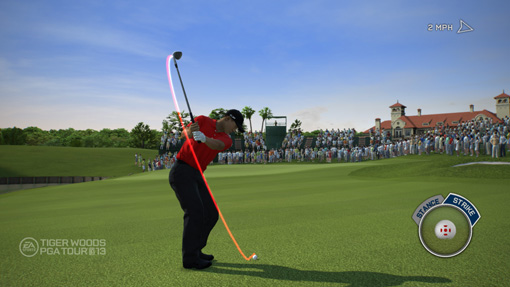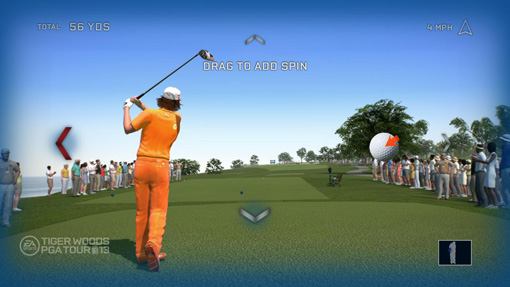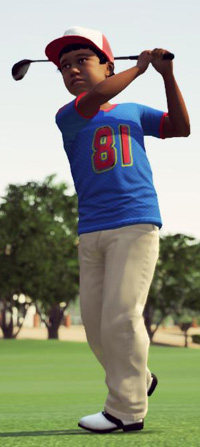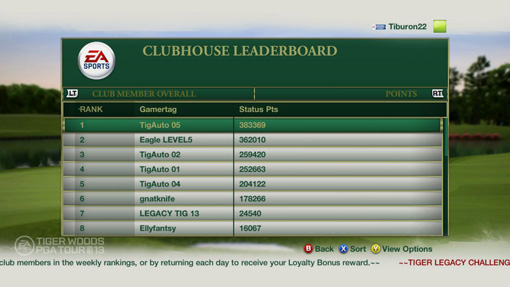Tiger Woods 13 Review: Motion-controlled golf finally comes to Xbox 360 thanks to Kinect. See how the arm-waving controls work in Matt's Tiger Woods 13 review.

Tiger Woods PGA Tour 13 continues EA Sports' long tradition of adding two significant features and leaving most everything else about this classic golf game intact. It's a lot like a typical golf course: you'll encounter about two unique traps on your way to the hole, but the height of the grass on the green is indistinguishable from year to year. Tiger Woods 11 added the Ryder Cup and a focus meter, while Tiger Woods 12, last year's edition, introduced the Masters Tournament at Augusta National Golf Club and advice-dispensing caddies. Tiger Woods 13 sees all of these highlights return along with a new pair of standout features: new swinging mechanics including the use of Kinect motion controls and a unique Legacy Challenge mode.
Kinect and New Swinging Mechanics
Tiger Woods 13's new swinging mechanics allow you to fine-tune your drive toward the hole with a fresh interface, which starts with a swing plane that creates a circular line around your golfer. This helpful guide that cleverly envelopes your golfer allows you to tell whether or not your swing is straight
as the club travels the plane. There's no detached meter off to the side telling you this anymore. It also indicates how far you should pull your club back to avoid overswinging or underswinging. While the new swing plane helps dictate distance and accuracy, a diagram in the bottom right corner of the screen sets up your feet (for draw and fade shots) and gives you a ball-striking meter for hitting balls thin and fat (when in a bunker).
Tiger Woods 13 has the best interface yet. However, that's not the most significant change to the way you'll control this game on Xbox 360. EA Sports finally invited Kinect to the motion control party after debuting golf-swinging controls for the PS3 Move two years ago and the Wii remote just after that console's launch. Of course,
there's no Wii version of Tiger Woods 13 this year and using the Kinect to mime through a golf swing is the way to go vs. PS3's Move. It just goes to prove that good things come to gamers who wait.

Swinging an imaginary golf club using Kinect feels very natural, albeit you're doing it facing forward and swinging left to right, not facing sideways swinging into the screen like you'd expect. This is because the camera needs to see both of your hands. Granted, you can always adjust the Kinect to the side of your room, but then you might have to move things around (like even more furniture). Regardless, swinging is fun and calling out commands like УAim Shot,Ф УAsk Caddy,Ф and УChange ClubФ is near-flawless. Kinect knows everything that's in your virtual golf bag, too, so calling for a У9-IronФ will instantly put the correct club in your golfer's hands.
But while the swinging controls and voice commands like УAim ShotФ work well, actually aiming the shot after getting to that menu is a little tricky. You're supposed to reach out toward the Kinect, then form a fist and finally move your fist in the direct you want the marker to move to. The idea here is that you're supposedly pulling the screen. Sounds great on paper, but not when the camera can't see your fist half of the time. Also, setting up the perfect shot and then having the camera not realize you are no longer making a fist leads to the marker chaotically moving far away from that perfectly setup location. These false positive fists are never fun. It's not all of the time, but it's an annoyance nonetheless. The same can be said for the actual menu system before stepping foot on the green. Moving the menu right to left or up and down in an attempt to browse the game types is a chore with the Kinect and a task better suited for a controller.
Tiger Woods 13 with Kinect gets the most important gameplay controls right: swinging and issuing commands, and that's great for a first effort. It's no where as in-depth as using a controller, which is when the new swing plane really matters and actually makes the gameplay more difficult. And to be fair, it's not supposed to be challenging. It's supposed to get more people into this golf franchise, and as long as they can navigate through the annoying menu system, that's a goal Kinect can meet. To top it off, after using Kinect, I can say that it feels better to mime a golf club than to hold a plastic wand - it almost feels magical.

 Legacy Challenge
Legacy Challenge
Speaking of magic, Tiger Woods' career from age 2 all the way to 36 has been fascinating to watch. Clearly, Someone at EA Sports thought it'd be even better to live out his best moments, even the ones in which he was just a child prodigy. Legacy Challenge mode fulfills that desire, as you start off playing as a two-year-old Tiger Woods chipping-and-putting on the Mike Douglas Show. This skills-based mode moves on with various challenges split up into his toddler years, early years, junior years, amateur years, rookie years, tiger slam days, pro years, present day and finally forward looking future days and record book 2019. What happens then? Tiger Woods' goal of beating Jack Nicklaus' major championship record. The retired Nicklaus leads with 18 major golf championships, while the present-day Tiger Woods sits at 14.
Legacy Challenge is an inventive way to get us to brush up on our golf gameplay skills without having us enter into a dull-sounding practice mode (which we couldn't do anyway). It's a great trick, but this cinematic Tiger-in-the-making mode could be even better if it weren't for a few irritating decisions. The first is the inability to restart a challenge midway through, even though you know you've pretty much blown the goal. You
have to fail it. For example, one challenge requires you to knock three balls from the rough to no more than a total of 15 feet from the hole. If the first shot lands 13 feet from the hole, chances are you're going to be doing this challenge all over again. But you have to hit at least the next ball and hope to fail to get the inevitable УTry AgainФ screen out of the way.
It's never good to want to fail in a game just to restart. Including an option (besides Quit Game) is a no-brainer.
It wouldn't be so bad if the load times weren't an issue. While I didn't notice significant load times in the main mode, they stand out like a sore thumb in this supposed-to-be-fast-paced game type. Worse, most of the 53 challenges are broken up into multiple parts, and while you don't have to restart at Part 1 if you lose at, say, Part 2, the developer oddly decided to make the restart button B instead of the natural A on Xbox 360 (or Circle instead of X on PS3). Your brain is trained to press A through the pointless messages and load times and for good reason: that's how it works in every other menu in the game. But in this one case, A is for Exit and B is for restarting from the part you're currently on. Even more strange, the УRestart Part 2Ф has an УAre you sureФ confirmation question whereas Exit does not. It's too easy to throw away all of your progress, and that zaps the fun out of this otherwise enjoyable mode.
 Pins and Online Country Clubs
Pins and Online Country Clubs
Pins and Online Country Clubs round out the new, but certainly less game-changing features found in Tiger Woods 13. Golfer pins add a +1s to specific golfers, while Boost pins improve things like your drive attributes, accuracy and the amount of experience points you'll earn. Both Golfer and Boost pins are equipped to your bag tag before the start of every round. In a way,
experimenting with various pins before hitting off each tee is a lot like applying Call of Duty perks - only these perks are used on a much more tranquil battlefield. Course pins, the third and final type of pin, also provide a course specific perk on top of the equipped Golfer and Boost pins. All three pin types can be leveled up from bronze to silver to gold.
Online Country Clubs allow you and a bunch of friends (or other online gamers) to create and join a country club for some exclusive competition. Taking your club from a starter country club to a five-star legend country club is an overarching goal, but the real week-to-week objective is to remain the club champion on the leaderboards and eventually represent the club in future EA Sports club champion events.
Both Pins and Online Country Clubs fully embrace the pay-to-access model that every company seems to be putting in place. Online Country Clubs and online play in general is hidden behind an Online Pass (one comes with the game, but it's $15 if you buy used), while Pins are free to earn, but gamers (or I should say non-gamers) can just buy pins and level-up without putting any effort into the game at all. The same applies to downloadable courses; there are 20 downloadable courses and 16 on the disc. You can earn rounds of play on these courses or, with enough effort, unlimited rounds... or purchase coins to skip ahead.
Tiger Woods 13 hasn't held back on joining the microtransaction future. I'll leave it to you to judge whether or not that is a good thing.